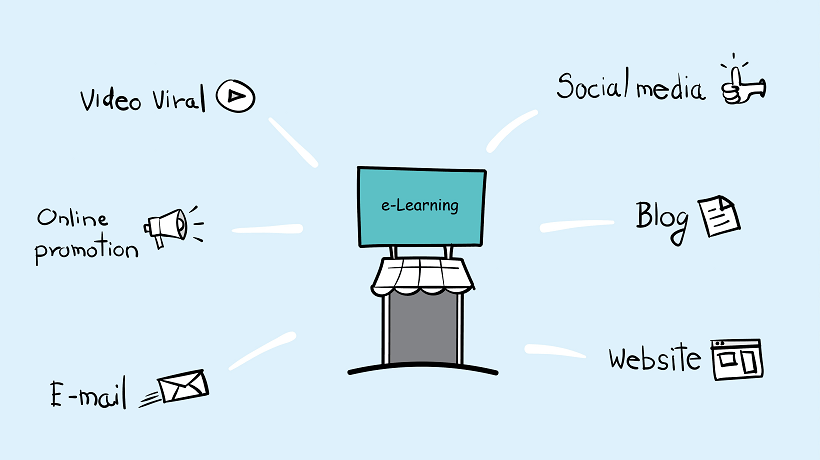The Ultimate Guide To Successful eLearning Implementation At The Workplace
The eBook The Ultimate Guide To Successful eLearning Implementation At The Workplace is an attempt to deconstruct the elements needed to make an eLearning implementation initiative successful. We start from the seemingly basic but invaluable question: ‘What is your goal?’. We then go on to explain how this goal, in conjunction with subsequent decisions, can guide you in creating an effective strategy, and then design, implement, and roll out programs for lasting success. We take an in-depth look at evaluation, describing in detail when it should be thought about, planned for, and implemented.
What This eBook Covers
The eBook is divided into 5 sections, as detailed below:
Section 1: Defining A Workplace eLearning Strategy That Works
This first section takes a look at what a good workplace e-learning strategy looks like, and describes the steps that can be followed to define one. Here is an overview of what we cover in this section:
- Identify what you want to accomplish, why, and in what timeframe.
- Understand where you currently are vis-à-vis the goal.
- Identify evaluation parameters.
- Consider the entire gamut of learning in relation to the organization’s culture.
- Take into account what is needed, and what is available.
- Determine how often content would need updation.
- Think about how learning would fit into your employees’ day.
- Consider who needs to come onboard, and when.
- Think about tools and technologies.
Most importantly, this section seeks to answer the 2 questions:
- Why is it important to define an eLearning strategy?
- What are the elements of a good strategy document?
Section 2: Considerations For Selecting An eLearning Vendor-Partner
In this section, we deep dive into the considerations for answering the one big question that organizations typically have when embarking on an eLearning initiative: ‘What should we develop in-house, and what should we outsource?’. We seek to cover this as well as other points such as:
- Consider your capabilities, both at present and in future: Here, we provide a description of the basic roles / profiles that an eLearning project would typically involve.
- Choose an eLearning vendor-partner: Here, we attempt to describe all the parameters for choosing a vendor-partner. Some of these, such as experience, expertise, size of company, etc., are obvious, while others are not so obvious.
Section 3: Designing Workplace eLearning Programs For Lasting Success
This section takes a high-level look at the design elements that make an eLearning program successful, without getting into specific approaches for instructional design. The elements discussed here include:
- Defining what success means.
- Defining the learning / performance outcomes.
- Putting practice first.
- Considering various forms and methods of learning delivery, to support learners in the best ways possible.
- Using templates.
Section 4: Selling Your eLearning Program To Learners And Keeping Them Hooked
The fourth section is all about ‘selling’ the eLearning courses to learners, to motivate them to:
- Enroll in the course, go through the same, and learn from it.
- Take action, that is, perform the intended behaviors, after completing the course.
- Continue to exhibit the desired behaviors.
This section talks about various ideas to do the above, touching upon points such as creating a brand identity, and designing a campaign not just to spread awareness and to nudge learners towards taking the courses, but also to urge them towards exhibiting the desired behaviors.
Section 5: Creating An eLearning Evaluation Plan
This section takes a look at evaluation as a process that takes place (or should take place) at the design stage. It covers evaluation at six levels, and provides a template that be used for designing evaluation for any course or learning initiative. The levels covered include:
- Participation (example: “72% of the learner population logged in and viewed the courses”).
- Completion (example: “80 out of every 100 people who started a course completed it”).
- Engagement (examples: “the courses received an average learner satisfaction rating of 90%” or “we received an average of 50 likes and 12 comments per course”).
- Learning (example: “90% of the learners who took the courses passed the end-of-course assessment”).
- Application (examples: “60% of those who went through the courses demonstrated improved skills / on-the-job performance” or, at a more specific course level “60% of those who went through the course on plant safety actually followed safety procedures while in the factory premises”).
- Results (example: “Safety incidents came down 8% in the three months following the rollout of the course”.
To download this eBook, click The Ultimate Guide To Successful eLearning Implementation At The Workplace.
Looking to implement eLearning in your organization? Please get in touch with us at [email protected].
Related articles:
1. The Ultimate Guide To Creating An eLearning Evaluation Plan
2. 4 Ways To Sell Your eLearning Program To Learners
3. 10 Considerations For Selecting An eLearning Vendor-Partner
4. 9 Steps To Defining A Workplace eLearning Strategy That Works







